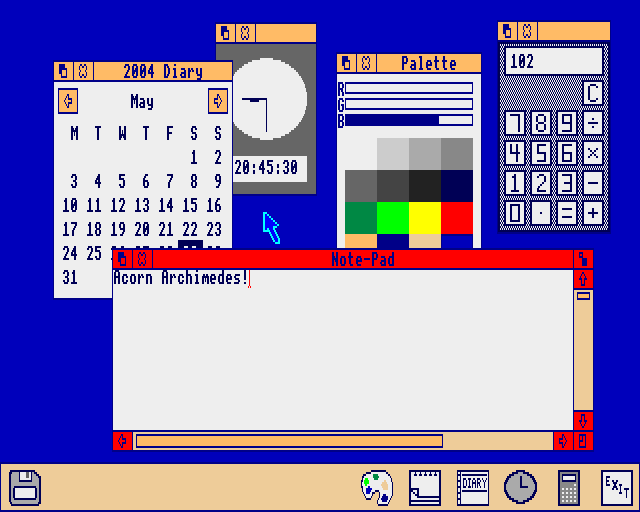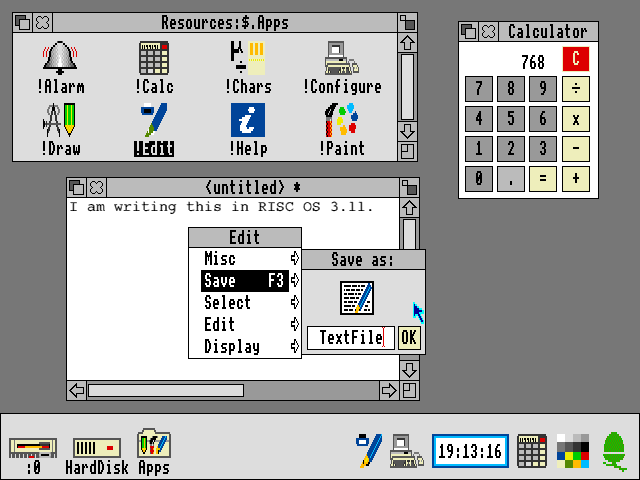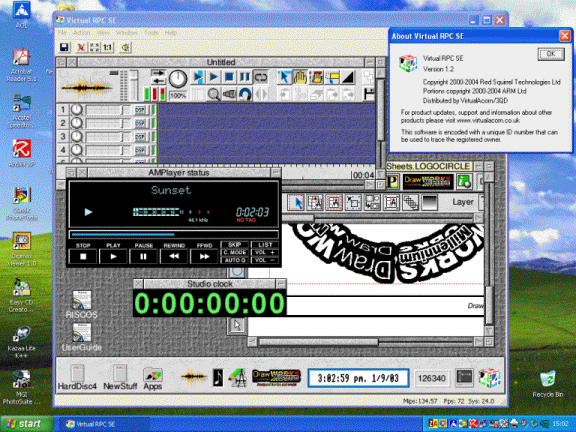Memories are made of this
If we rule out the inclusion of the plastic mechanical computer kit I assembled thanks to "Meccano" magazine at the end of the 1960s, my first foray into home PCs came quite late (after more than a decade in the IT industry, in fact), back in 1985, with an Amstrad PCW word processing system (256K RAM, monitor, keyboard, printer, one diskette system for £399) — anyone else remember the amazingly capable LocoScript? — one of the first 14 sold by Dixons in Southampton.
It was basically a Z80-based CP/M machine. And it paid for itself very quickly when I was sub-contracted to work on a series of defence-industry oriented patent abstracts for my friend Hugh in his post-Haymarket hi-fi magazine editor days.
I actually congratulated Alan Sugar at a trade show some time later when he introduced a very cheap IBM PC compatible machine. Not all my IBM colleagues felt I should have done, which surprised me. I guess "NIH" is alive and well everywhere you go.
4 MHz ARM2
I moved into the Acorn world in 1989 as a happy innocent with a £3,800 4MB A440 (think 14x the speed of the original IBM PC in 1981) with a 20MB disk and dot matrix printer all paid for by IBM for writing the first edition of CICS: a light hearted chronicle. The A440 had a perfectly adequate word processing system (anyone remember 1stWordPlus?) and the process of file exchange between Acorn and IBM was much helped by one of my young colleagues who, when not teaching karate, could work the necessary command-line incantations that did the magic between the Acorn's 1.6MB ADFS format diskettes and good ol' 1.44MB Microsoft DOS format on an OS/2 machine and thus on to the LAN we had at the time.
It would be hard not to describe the initial OS I contended with — Arthur 1.2 — as having a somewhat garish appearance :-)

Though the Acorn offered an entry level DTP capability, my real (but unrevealed) motivation for insisting on it had actually been to get my mitts on a wonderful visual interface relational database "card index" system (anyone remember System DeltaPlus?) for tracking the odd book, video, and bit of music. I was not the only Acorn RISC enthusiast in the IBM laboratory, by the way...
Within a couple of years the OS had ticked along through RISC OS 2 and along to RISC OS 3.11, which was a fully co-operative pre-emptive multi-tasking delight by comparison with the clunky Windows and OS/2 offerings of that time. (OS upgrades basically simply involved buying and fitting a new set of system ROMs on the motherboard. Similarly, upgrading the processor involved a small handful of new chips and some careful delving around.) Here's RISC OS 3.11:

RISC OS had many features (WIMP desktop, tiny power consumption, blazingly fast and efficient performance [only 16 hardware instructions, after all, one of them a NOP] and an essentially virus-proof operating system all contained in fast-loading ROM, integrated sound, scaleable anti-aliased font manager, object-oriented vector graphics, BBC BASIC built-in, a really cool spacecraft lander demo [written in BASIC, but well able to blow away the Amiga's bouncing ball!]) only some of which slowly appeared in the Windows world. By the way, Apple used to claim in their adverts to be the first purveyor of desktop RISC PC systems until Acorn got that particularly dirty trick stopped.
25 MHz ARM3
The A440 lasted me well and I naturally rewarded it by giving it an 84MB SCSI disk, a 25MHz ARM3 processor (with an enormous 4KB cache, I believe) and a laser printer driven via a so-called video interface (anyone remember LaserDirect?) that squeezed 600 dpi and 4 ppm out of a basic Canon print engine by some very clever interpolation. The system, of course, blew spots off the Amstrad CP/M Z80 system from Day 1. But, as PCs and dogs always do, it died on me. This was in 1993 just as I once again needed a home PC "for real work". Hence its hastily-ordered replacement, an 8MB A5000 with about 150MB disk — happily also all paid for by IBM. This time, for writing the second edition of CICS: a light hearted chronicle. A copy of which now lives in the Smithsonian :-)
30 MHz? ARM7? 200 MHz, StrongARM!
This was all very well, but on a visit to the "local" Acorn store1 I checked out and then bought what was to be my final Acorn: a 32MB RISC-PC700 [paid for by me]. This I upgraded to 64MB and (in 1996) I also gave it a heart transplant with the new 200MHz StrongARM2 processor and various lumps of further disk, all of which was inevitably but most reluctantly displaced3 in very late 2002 by an "industry standard" 512MB 2.5GHz Pentium 4 of some sort [paid for by me].
This system (not cheap, at over £2,500) was very effectively crippled by its Windows XP Pro operating system, though it was in an admittedly-neat little Shuttle case. Mind you, I soon installed VirtualAcorn — this enabled me to emulate an A5000 entirely "in" an XP window (and therefore run all my software and retrieve all my data) at about 150% of the speed of the real thing. I guess, when you only have 16 instructions to handle, it's not that hard to write a good emulator. (Even on a PC.)
I've always preferred to keep application data physically away from the OS space, though not too many Windows applications are fully co-operative in that respect. This was merely the first of the series of nasty culture shocks I experienced when reluctantly migrating (after 13 years of effortless [dare one say "Mac-like"?] 'productivity') from Acorn's RISC-OS. Despite the enormous difference in processor speed, the most delightful aspect of the Intel was this ability to emulate my familiar RISC-OS environment...
... while I migrated as much of my data as was feasible.
